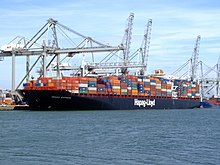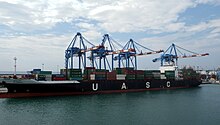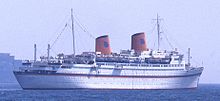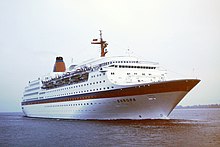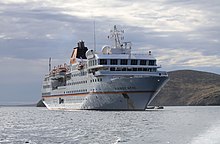Hapag-Lloyd Flug GmbH was a German leisure airline headquartered in Langenhagen, Lower Saxony that was originally founded by Hapag-Lloyd and later became a subsidiary of TUI Group. It operated scheduled and charter passenger flights mainly to holiday resorts in Europe. Its successor is today's TUI fly Deutschland.

Royal Caribbean Group, formerly known as Royal Caribbean Cruises Ltd., is a global cruise holding company incorporated in Liberia and based in Miami, Florida. It is the world's second-largest cruise line operator, after Carnival Corporation & plc. As of March 2024, Royal Caribbean Group fully owns three cruise lines: Royal Caribbean International, Celebrity Cruises, and Silversea Cruises with 65 ships in the current fleet and 5 ships on order until 2028. They also hold a 50% stake in TUI Cruises and Hapag-Lloyd Cruises.

TUI Group is a German leisure, travel and tourism company; it is the largest such company in the world. TUI is an acronym for Touristik Union International. TUI AG was known as Preussag AG until 1997 when the company changed its activities from mining to tourism. It is headquartered in Hanover, Germany.

The Hamburg-Amerikanische Packetfahrt-Actien-Gesellschaft (HAPAG), known in English as the Hamburg America Line, was a transatlantic shipping enterprise established in Hamburg, in 1847. Among those involved in its development were prominent citizens such as Albert Ballin, Adolph Godeffroy, Ferdinand Laeisz, Carl Woermann, August Bolten, and others, and its main financial backers were Berenberg Bank and H. J. Merck & Co. It soon developed into the largest German, and at times the world's largest, shipping company, serving the market created by German immigration to the United States and later, immigration from Eastern Europe. On 1 September 1970, after 123 years of independent existence, HAPAG merged with the Bremen-based North German Lloyd to form Hapag-Lloyd AG.
Norddeutscher Lloyd was a German shipping company. It was founded by Hermann Henrich Meier and Eduard Crüsemann in Bremen on 20 February 1857. It developed into one of the most important German shipping companies of the late 19th and early 20th centuries, and was instrumental in the economic development of Bremen and Bremerhaven. On 1 September 1970, the company merged with Hamburg America Line (HAPAG) to form Hapag-Lloyd AG.

The Port of Hamburg is a seaport on the river Elbe in Hamburg, Germany, 110 kilometres (68 mi) from its mouth on the North Sea.
Italian Line and from 1992 Italia Line, whose official name was Italia di Navigazione S.p.A., was a passenger shipping line that operated regular transatlantic services between Italy and the United States, and Italy and South America. During the late 1960s the company turned to running cruises, and from 1981 it became a global freight operator.

SS Vaterland was a transatlantic ocean liner that was launched for the Hamburg America Line in 1940 but left incomplete because of the Second World War. An Allied air raid damaged her in 1943, and she was scrapped in 1948.

SS Pasteur was a steam turbine ocean liner built for Compagnie de Navigation Sud-Atlantique. She later sailed as Bremen for Norddeutscher Lloyd. In the course of her career, she sailed for 41 years under four names and six countries' flags.

SS Scharnhorst was a Norddeutscher Lloyd ocean liner, launched in 1934, completed in 1935 and made her maiden voyage on 8 May 1935. She was the first big passenger liner built by the Third Reich. Under the German merchant flag, she was the second liner named after General Gerhard J. D. von Scharnhorst. She was one of three ships on the Far Eastern route between Bremen and Yokohama; her sister ships were Potsdam and Gneisenau. These three ships were planned to shorten the journey time between Bremen and Shanghai from the usual 50 days to 34. She was trapped in Japan in September 1939 and later converted into an Imperial Japanese Navy aircraft carrier named Shin'yō in 1942 and sunk by the US submarine USS Spadefish in 1944.
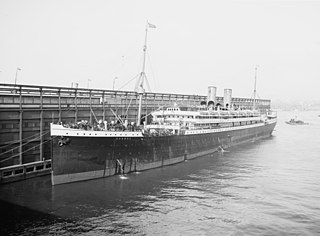
The Barbarossa class was a class of ocean liners of North German Lloyd and the Hamburg America Line of the German Empire. Of the ten ships built between 1896 and 1902, six were built by AG Vulcan Stettin, three were built by Blohm & Voss, and one was built by Schichau-Werke; all were built in Germany. They averaged 11,000 gross register tons (GRT) and featured twin screw propellers driven by quadruple-expansion steam engines.
Lykes Bros. Steamship Co., also called Lykes Lines, was a cargo shipping company acting from the beginning of the 20th century to 2005 having its main business in the trade to and from the United States.
Hamburger Hafen und Logistik AG, known until 2005 as Hamburger Hafen- und Lagerhaus-Aktiengesellschaft, and prior to that as Hamburger Freihafen-Lagerhaus Gesellschaft (HFLG) since 1885, is a German logistics and transportation company specialising in port throughput and container and transport logistics.

CSAV is a Chilean shipping company that is currently the largest company of its type in Latin America and also one of the oldest ones, having been founded in 1872.
TUI Cruises is a cruise line based in Germany. It was formed in 2007 as a joint venture between the German tourism company TUI AG and the American cruise line operator Royal Caribbean Group, both of whom hold a 50% stake in the company.

Deutsche Ost-Afrika Linie was a shipping line, established in 1890 as an alternative to the existing shipping services to East Africa, including German East Africa (1891–1919), then dominated by United Kingdom shipping lines.
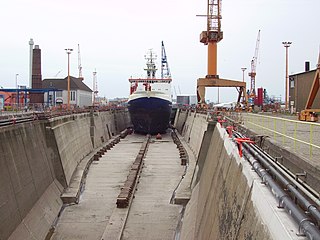
Lloyd Werft Bremerhaven GmbH is a dockyard in Bremerhaven. It was founded in 1863 by the shipping company Norddeutscher Lloyd, first mainly used as a repair workshop for the company’s own merchant fleet. This new yard was established in exchange and addition to the former small Lloyd-workshop in Bremen which was already founded in 1857.

Tokio Express was a container ship, built and registered in Hamburg in 1973 for Hapag-Lloyd. In 1984 she was renamed Scandutch Edo before being acquired by Pol Gulf International in 1993 and restored to her original name. In 1997, she was acquired by Westwind International and in 1999, by Falani, before being broken up for scrap in 2000.

SS Burdigala was an ocean liner that sailed the Atlantic Ocean from 1898 until World War I. The ship was built as the Kaiser Friedrich in 1898 for Norddeutscher Lloyd (NDL), a German shipping line. Designed to break the speed record for a transatlantic liner and thereby win the Blue Riband, the Kaiser Friedrich never achieved the necessary speeds. After a short career with NDL and an equally short period of service with NDL's main German competitor, the Hamburg-Amerikanische Packetfahrt-Aktien-Gesellschaft, the ship was mothballed for a decade. After being sold to the French shipping line Compagnie de Navigation Sud-Atlantique, it re-entered service as SS Burdigala. In 1916, while en route from Thessaloniki to Toulon, the liner struck a mine laid by the German U-boat U-73 in the Aegean Sea and sank near Kea, Greece.

Hapag-Lloyd Cruises is a German cruise line that operates smaller luxury ships on worldwide itineraries, along with three expeditions ships.





